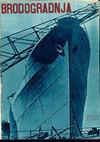船用燃气轮机倾斜喷嘴多喷嘴喷射器的数值研究
IF 4.2
4区 工程技术
Q1 ENGINEERING, MARINE
引用次数: 0
摘要
在船用燃气轮机中,高温废气和喷射器的热表面会产生大量的红外辐射。适当的喷嘴结构可以有效降低排气温度,减少高温辐射表面积,从而最大限度地减少外部红外辐射。本文采用计算流体力学(CFD)方法对喷射器的喷嘴结构进行了数值模拟。通过研究喷嘴倾角与喷嘴数量的正交组合,分析了不同工况下的温度分布和流动特性。结果表明:随着喷管倾角的增大,喷管的夹带系数(Ce)和进出口温度比(Rt)先增大后减小;同时,压力损失系数(Cpl)随倾角增大而增大。采用CRITIC权重法客观分配Rt、Ce和Cpl的权重,确定最优解。结果表明,Rt和Cpl具有显著且相似的权重。案例10 (α = 5°,x = 4)的最优解为Ce=2.38, Cpl=11.45, =0.68。研究结果对提高船用燃气轮机的性能,减少外部红外辐射具有重要意义。本文章由计算机程序翻译,如有差异,请以英文原文为准。
Numerical investigation of multi-nozzle ejector device with inclined nozzles for marine gas turbine
The high-temperature exhaust gases and the hot surfaces of the ejector device in marine gas turbines generate significant levels of infrared radiation. An appropriate nozzle structure can effectively lower the exhaust gas temperature and reduce the high-temperature radiation surface area, thereby minimizing external infrared radiation. In this study, a numerical simulation of the nozzle structure in the ejector device was conducted using computational fluid dynamics (CFD) methods. By investigating the orthogonal combinations of nozzle inclination angles and the number of nozzles, the temperature distribution and flow characteristics under different operating conditions were analysed. The results showed that as the nozzle inclination angle increased, the entrainment coefficient (Ce) and the temperature ratio at the inlet and outlet (Rt) initially improved but then worsened. Simultaneously, the pressure loss coefficient (Cpl) increased with the inclination angle. The CRITIC weight method was employed to objectively allocate weights to Rt, Ce, and Cpl, determining the optimal solution. The results indicated that Rt and Cpl had significant and similar weights. The optimal solution was found in Case 10 (α = 5°, x = 4), with corresponding evaluation indices of Ce=2.38, Cpl=11.45, and =0.68. This study's findings are of great importance for enhancing the performance of marine gas turbines and reducing external infrared radiation.
求助全文
通过发布文献求助,成功后即可免费获取论文全文。
去求助
来源期刊

Brodogradnja
ENGINEERING, MARINE-
CiteScore
4.30
自引率
38.90%
发文量
33
审稿时长
>12 weeks
期刊介绍:
The journal is devoted to multidisciplinary researches in the fields of theoretical and experimental naval architecture and oceanology as well as to challenging problems in shipbuilding as well shipping, offshore and related shipbuilding industries worldwide. The aim of the journal is to integrate technical interests in shipbuilding, ocean engineering, sea and ocean shipping, inland navigation and intermodal transportation as well as environmental issues, overall safety, objects for wind, marine and hydrokinetic renewable energy production and sustainable transportation development at seas, oceans and inland waterways in relations to shipbuilding and naval architecture. The journal focuses on hydrodynamics, structures, reliability, materials, construction, design, optimization, production engineering, building and organization of building, project management, repair and maintenance planning, information systems in shipyards, quality assurance as well as outfitting, powering, autonomous marine vehicles, power plants and equipment onboard. Brodogradnja publishes original scientific papers, review papers, preliminary communications and important professional papers relevant in engineering and technology.
 求助内容:
求助内容: 应助结果提醒方式:
应助结果提醒方式:


